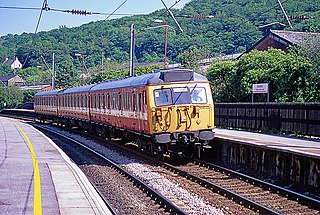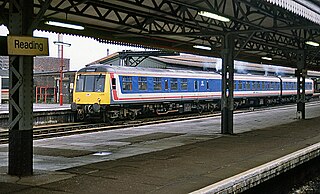
Gatwick Express is an express rail passenger service between London Victoria, Gatwick Airport, and Brighton in South East England. It is the brand name used by the Govia Thameslink Railway train operating company on the Gatwick Express route of the Thameslink, Southern and Great Northern franchise.

InterCity was introduced by British Rail in 1966 as a brand-name for its long-haul express passenger services.

A Driving Brake Standard Open (DBSO) is a type of railway carriage in Great Britain, converted to operate as a control car; this is not to be confused with DVTs, such as those in InterCity 225 sets. Fourteen such vehicles, numbered 9701 to 9714, were converted from Mark 2F Brake Standard Open carriages. Modifications included adding a driving cab and TDM equipment to allow a locomotive to be driven remotely. Using a system known as push–pull, the driver in the DBSO can drive the locomotive, even though it is at the rear of the train.

The British Rail Class 312 alternating current (AC) electric multiple units (EMUs) were built between 1975 and 1978 for use on outer-suburban passenger services. It was the last class of multiple unit to be constructed with the British Rail Mark 2 bodyshell, as well as the last class of multiple unit to be built with slam doors in Britain. These features contributed to their relatively early withdrawal at 25–28 years old, compared with a typical EMU life expectancy of 30–40 years.

The British Rail Class 73 is a British electro-diesel locomotive. The type is unusual in that it can operate from the Southern Region's 650/750 V DC third-rail or an on-board diesel engine to allow it to operate on non-electrified routes. This makes it very versatile, although the diesel engine produces less power than is available from the third-rail supply so the locomotives are rarely operated outside of the former Southern Region of British Rail. Following the withdrawal and scrapping of the more powerful Class 74 electro-diesels in 1977, the Class 73 was unique on the British railway network until the introduction of the Class 88 electro-diesels in 2017. Ten locomotives have been scrapped.

The British Rail Class 488 are unpowered trailer sets, converted from Mark 2F coaches for the Gatwick Express service from London Victoria to Gatwick Airport.

The British Rail Class 423, electric multiple unit passenger trains were mostly built by British Rail (BR) at York Works from 1967 to 1974, although the MBSOs and TSOs of the first 20, 7701-7720, were built at Derby Works. They have manually opening doors next to every seating row and were the last coaching stock built in this pattern for BR. They were mostly found working outer-suburban services in South London and rural services in Kent, Sussex and Hampshire, up to 2005 when they were finally replaced by Electrostar and Desiro units. The fleet had a working life of 38 years.

The British Rail Classes 101 and 102 diesel-mechanical multiple units were built by Metro-Cammell at Washwood Heath in Birmingham, England from 1956 to 1959, following construction of a series of prototype units. These classes proved to be some of the most successful and longest-lived of BR's First Generation DMUs, second in longevity only to the Class 121, with the final five units being withdrawn on 24 December 2003. The oldest set was, by then, just over 47 years old.

The British Rail Class 308 alternating current (AC) electric multiple units (EMU) were built by British Railways' Holgate Road carriage works in three batches between 1959 and 1961. They were initially classified as AM8 units before the introduction of TOPS.

The British Rail Class 460 (8-GAT) was a class of electric multiple-unit passenger trains built by Alstom at Washwood Heath between 1999 and 2001. They were part of Alstom's Juniper family, which also includes Classes 334 and 458.

The British Rail Class 309 "Clacton Express" electric multiple units (EMUs) were built by British Rail (BR) York Carriage Works from 1962–1963. They were initially classified as Class AM9 before the introduction of TOPS. These units were the first express 25 kV alternating current (AC) units to be built by British Rail and were their first EMUs capable of 100 mph.

British Rail was the brand image of the nationalised railway owner and operator in Great Britain, the British Railways Board, used from 1965 until its breakup and sell-off from 1993 onwards.

The Mark 2 family of railway carriages are British Rail's second design of carriages. They were built by British Rail workshops between 1964 and 1975. They were of steel construction.

The British Rail Class 442 (5-WES) Wessex Electrics were electric multiple unit passenger trains introduced in 1988 by Network SouthEast on the South West Main Line from London Waterloo to Weymouth to coincide with the electrification of the line from Bournemouth. Twenty-four five-car units were built by British Rail Engineering Limited's Derby Litchurch Lane Works.
The Southern Region was a region of British Railways from 1948 until 1992 when railways were re-privatised. The region ceased to be an operating unit in its own right in the 1980s. The region covered south London, southern England and the south coast, including the busy commuter belt areas of Kent, Sussex and Surrey. The region was largely based upon the former Southern Railway area.

The British Rail Class 306 was a type of electric multiple unit (EMU) introduced in 1949. It consisted of 92 three-car trains which were used on the Great Eastern Main Line between Shenfield and London Liverpool Street.

The British RailClass 414 were two-car electric multiple units that were built between 1956 and 1963. They were withdrawn in 1995.

The British Rail Class 119 DMUs were used throughout the Western Region and on services in the Midlands sourced by Tyseley Depot. Built by the Gloucester Railway Carriage & Wagon Co. Ltd, the body design was based on the Swindon Cross-Country sets, but with a Derby cab. Sets were normally formed of three cars.

The Alstom Coradia Juniper series is a family of electric multiple unit trains built by Alstom Transport Birmingham for use on the railway network in Great Britain. The family is related to the Coradia 1000 series of diesel multiple units.

The British Rail Class 387 is a type of electric multiple unit passenger train built by Bombardier Transportation. They are part of the Electrostar family of trains. A total of 107 units were built, with the first train entering service with Thameslink in December 2014. The trains are currently in service with Great Western Railway, Govia Thameslink Railway, and Heathrow Express. The Class 387 is a variation of the Class 379 with dual-voltage capability which allows units to run on 750 V DC third rail, as well as use 25 kV AC OLE. The class were the final rolling stock orders from the Bombardier Electrostar family with 2,805 vehicles built over 18 years between 1999 and 2017.






















